In This Topic
Probability plot
Use the probability plot to assess how well the distribution that you selected fits your data. If the points closely follow the fitted line, then you can assume that the distribution fits the data reasonably well.
- The points on the plot are the estimated percentiles based on a nonparametric method, which does not depend on any distribution. When you hold your pointer over a data point, Minitab displays the observed failure time and the estimated cumulative probability.
- The fitted line (center line) is based on the fitted distribution. When you hold your pointer over the fitted line, Minitab displays a table of percentiles for various percents.
- The left line connects the lower bounds on confidence intervals for each percentile. The right line connects the upper bounds on confidence intervals for each percentile.
Example output
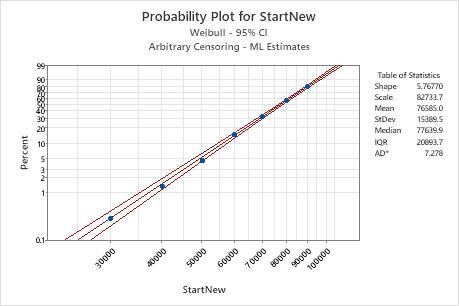
Interpretation
For the data on the new type of mufflers, the points appear to follow the fitted line. Therefore, you can assume that the Weibull distribution is an appropriate choice for the data. The fitted line is based on a Weibull distribution with shape = 5.76770 and scale = 82733.7.
Survival plot
The survival plot depicts the probability that the item will survive until a particular time. Thus, the survival plot shows the reliability of the product over time.
- The center line is the estimated reliability over time.
- The right line connects the upper bounds for the reliability at each time point. The left line connects the lower bounds for the reliability at each time point.
When you hold your pointer over the survival curve, Minitab displays a table of times and survival probabilities.
Use this plot only when the distribution fits the data adequately. If the distribution fits the data poorly, these estimates will be inaccurate. Use the distribution ID plot, probability plot, and goodness-of-fit measures to determine whether the distribution adequately fits the data.
Example output
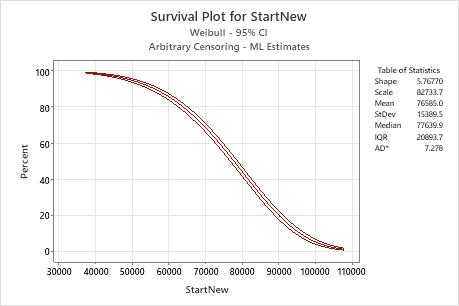
Interpretation
For the data on the new type of mufflers, the probability that the new type of muffler survives until 50,000 miles is approximately 95%. The survival function is based on the Weibull distribution with shape = 5.76770 and scale = 82733.7.
Cumulative failure plot
To describe product reliability in terms of when the product fails, the cumulative failure plot displays the cumulative percentage of items that fail by a particular time, t. The cumulative failure function represents 1 − survival function.
- The center line is the estimated cumulative failure percentage over time.
- The right line connects the lower bounds for the cumulative failure percentage at each time point. The left line connects the upper bounds for the cumulative failure percentage at each time point.
When you hold your pointer over the curve, Minitab displays the cumulative failure probability and failure time.
Use this plot only when the distribution fits the data adequately. If the distribution fits the data poorly, these estimates will be inaccurate. Use the distribution ID plot, probability plot, and goodness-of-fit measures to determine whether the distribution adequately fits the data.
Example output
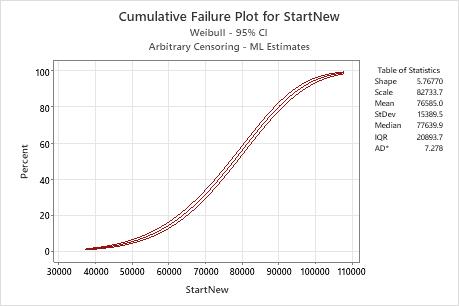
Interpretation
For the data on the new type of mufflers, the probability of the new type of muffler failing by 50,000 miles is about 5%. The cumulative failure function is based on the Weibull distribution with shape = 5.76770 and scale = 82733.7.
Hazard plot
- Decreasing: Items are less likely to fail as they age. A decreasing hazard typically happens in the early period of a product's life.
- Constant: Items fail at a constant rate. A constant hazard typically happens during the useful life of a product when failures occur at random.
- Increasing: Items are more likely to fail as they age. An increasing hazard typically happens in the later stages of a product's life, as in wear-out.
The shape of the hazard function is determined based on the data and the chosen distribution. When you hold your pointer over the hazard curve, Minitab displays a table of failure times and hazard rates.
Use this plot only when the distribution fits the data adequately. If the distribution fits the data poorly, these estimates will be inaccurate. Use the distribution ID plot, probability plot, and goodness-of-fit measures to determine whether the distribution adequately fits the data.
Example output
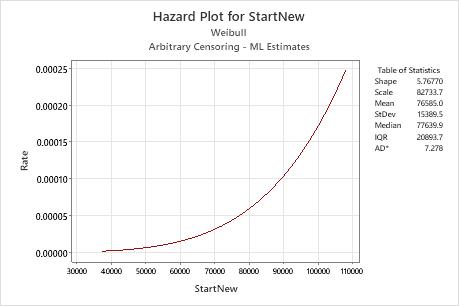
Interpretation
For the data on the new type of mufflers, the hazard function is based on the Weibull distribution with shape = 5.76770 and scale = 82733.7. Here, the hazard rate is increasing over time, which means that the new type of mufflers are more likely to fail as they age.
Multiple failure mode graphs
For the multiple failure data, Minitab displays graphs for each failure mode.
- Use the probability plot to assess how well the chosen distribution fits your data. If the points closely follow the fitted line, then use that distribution to model the data.
- Use the survival plot to assess the probability that the item will survive until a particular time. The survival plot displays the reliability of the product over time.
- Use the hazard function to provide the likelihood of failure as a function of how long a unit has lasted (the instantaneous failure rate at a particular time, t). The hazard plot shows the trend in the failure rate over time.
Example output
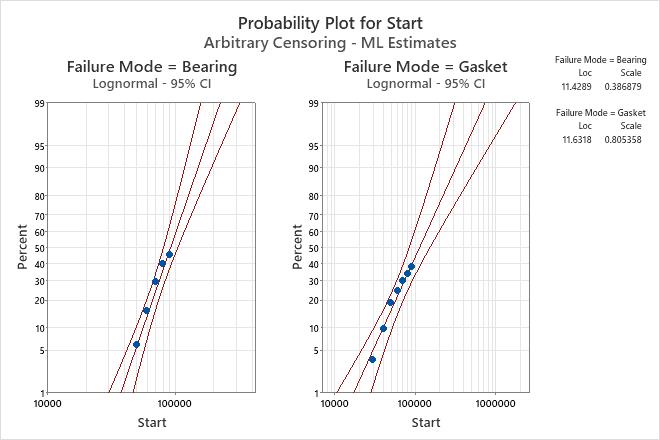
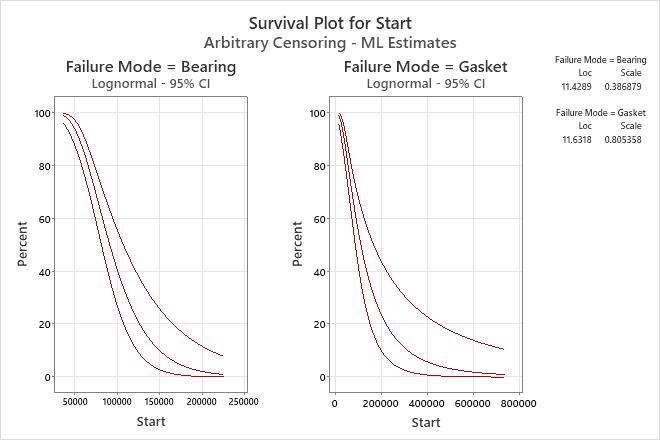
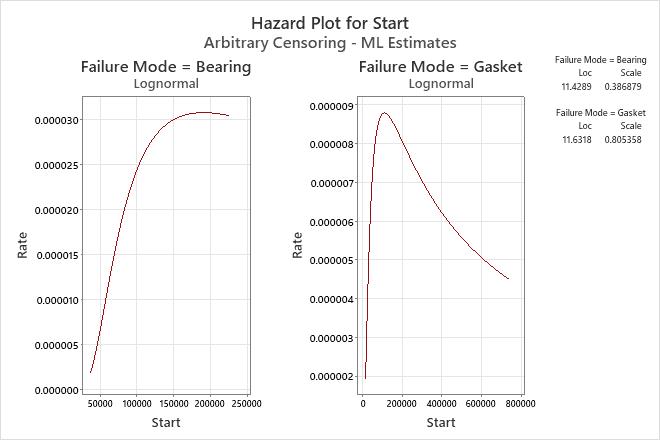
Interpretation
For the pump data, the lognormal distribution appears to be an appropriate choice to model both failure modes. The parameters are location = 11.4289 and scale = 0.386879 for the bearing failures, and location = 11.6318 and scale = 0.805358 for the gasket failures.
The probability that pumps will survive bearing failures for 70,000 miles is about 70%, and that they will survive gasket failures for that many miles is also about 70%.
The hazard rate for each failure mode increases slightly over time, but then decreases for gasket failures.
